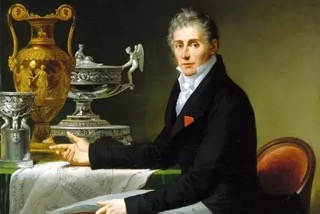
Silversmiths
Jean Baptiste Claude Odiot
House of Odiot
1763 — 1850
The House of Odiot was founded in 1690 by Jean-Baptiste Gaspard Odiot but rose to prominence under Jean-Baptiste Claude, Gaspard's grandson. Jean-Baptiste Claude was influenced by classical Greek and Egyptian motifs as expressed in the Directoire and Empire styles.
Odiot purchased many of Henry Auguste's models and designs following the 1809 bankruptcy of the neoclassical silversmith. Along with Martin-Guillaume Biennais, they soon replaced Auguste as Napoleon's silversmiths. Court commissions furthered the reputation of Maison Odiot, as it provided vermeil services to courts across Europe as well as commissions including Emperor Napoleon Bonaparte's coronation sword, sceptre and dinner service.
Upon his retirement in 1823, Jean-Baptiste Claude passed the business to his son Charles-Nicolas. He experimented with electroplating and worked in the revived rocaille style and by 1825 he was the purveyor of silverware by appointment to His Majesty King Louis-Philippe and the Royal Family of Orleans. He was later succeeded by his son Gustave who received a large commission of 3,000 pieces of solid gold flatware for Sa'd Pacha, the Viceroy of Egypt. Gustave was the last member of the Odiot family to preside over the company.
Drawing from its impressive archives of designs, patterns and moulds, Odiot's collection today is identical or close to the ones originally produced for European nobility and royal families.
Last Updated on: 2024-08-15
